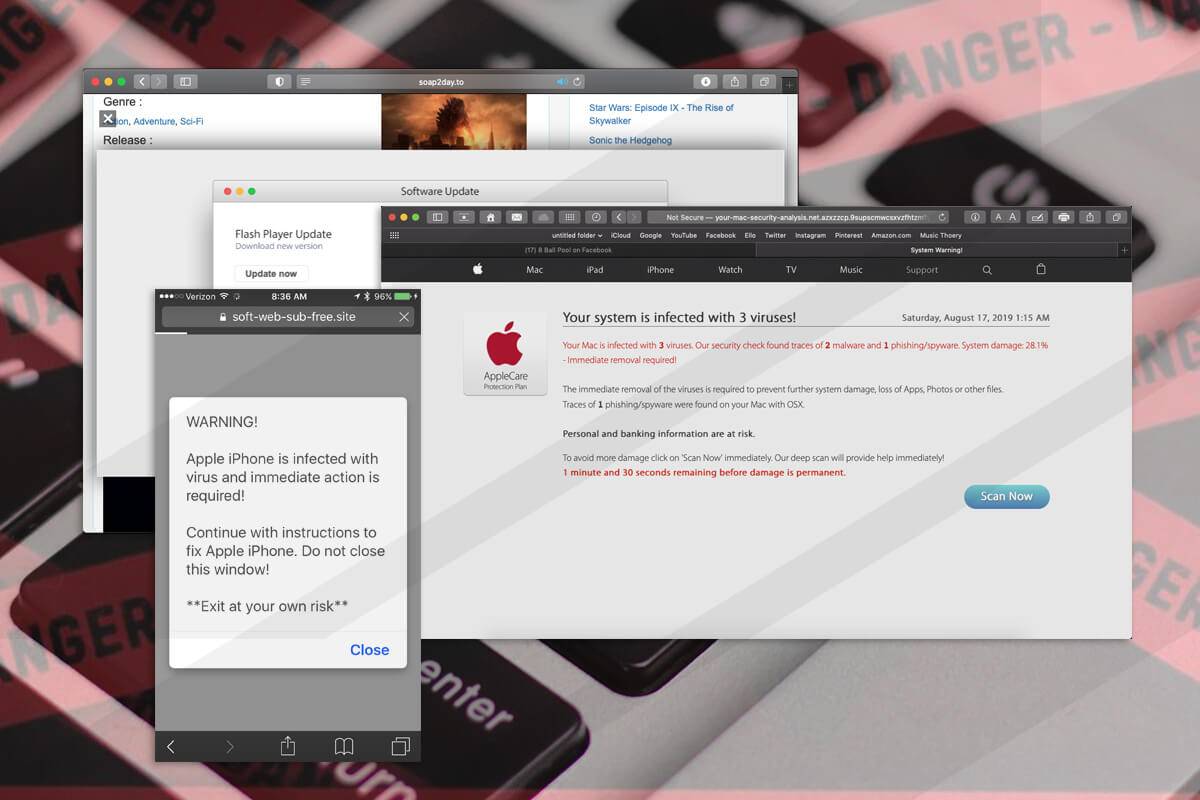Introduction
Safari is a popular web browser known for its sleek interface and robust security features. However, like any other software, it is not immune to potential security threats such as viruses and malware. If you suspect that your Safari browser has been compromised by a virus, it's crucial to take immediate action to safeguard your online privacy and protect your device from further harm.
In this comprehensive guide, we will walk you through the step-by-step process of removing a virus from Safari. By following these instructions, you can effectively eliminate any malicious software that may have infiltrated your browser, ensuring a secure and seamless browsing experience.
It's important to note that while Safari is designed with built-in security measures, including sandboxing and anti-phishing technologies, cyber threats continue to evolve, making it essential for users to remain vigilant and proactive in safeguarding their online activities. Whether you've noticed unusual pop-ups, unexpected redirects, or unexplained changes in your browser settings, addressing these issues promptly is crucial to prevent potential data breaches and system vulnerabilities.
By understanding the necessary steps to remove a virus from Safari, you can regain control of your browsing experience and mitigate the risks associated with malicious software. From updating Safari to utilizing reliable antivirus software, each step in this guide is designed to empower you with the knowledge and tools needed to combat potential security threats effectively.
Now, let's delve into the specific steps that will enable you to identify and eliminate any viruses or malware that may have compromised your Safari browser. By taking proactive measures to secure your browser, you can browse the web with confidence, knowing that your online activities are protected from potential security risks.
Step 1: Update Safari
Keeping your Safari browser up to date is a fundamental step in maintaining its security and performance. Updates often include patches for known vulnerabilities and security loopholes, making it essential to regularly check for and install the latest version of Safari. Here's how you can ensure that your Safari browser is updated to the latest release:
-
Check for Updates: Launch Safari and navigate to the "Safari" menu located in the top-left corner of the screen. From the drop-down menu, select "About Safari." A window will appear, indicating the current version of Safari installed on your device. If an update is available, a prompt to install the latest version will be displayed.
-
Install the Update: If a new version of Safari is available, click on the "Install" button to initiate the update process. Depending on your device's settings, you may be required to enter your system password to authorize the installation. Once the update is complete, Safari will restart with the latest version installed.
-
Automatic Updates: To streamline the update process, consider enabling automatic updates for Safari. This can be done by accessing the "App Store" settings on your device and enabling the option to automatically install app updates, including Safari.
By ensuring that your Safari browser is running the latest version, you can benefit from enhanced security features and performance improvements. Regular updates help mitigate the risk of potential security threats, as they often include fixes for known vulnerabilities that could be exploited by malicious entities. Additionally, staying current with Safari updates ensures compatibility with the latest web technologies and standards, providing a seamless and secure browsing experience.
In the next section, we will explore the importance of clearing Safari history and website data as part of the process to remove viruses from the browser. This proactive measure can help eliminate potential traces of malicious activity and enhance the overall security of your browsing environment.
Step 2: Clear Safari History and Website Data
Clearing your Safari history and website data is a crucial step in removing viruses and enhancing the security of your browsing experience. By eliminating potentially compromised data and eradicating traces of malicious activity, you can effectively safeguard your online privacy and mitigate the risks associated with harmful software.
To clear your Safari history and website data, follow these steps:
-
Open Safari Preferences: Launch the Safari browser and click on "Safari" in the top menu bar. From the drop-down menu, select "Preferences." Alternatively, you can use the keyboard shortcut "Command + ," to access the Preferences window.
-
Navigate to Privacy Settings: Within the Preferences window, navigate to the "Privacy" tab. Here, you will find options to manage website data, including cookies and other site-specific data stored by Safari.
-
Manage Website Data: Click on the "Manage Website Data" button to view the list of websites that have stored data on your device. You can choose to remove individual website data by selecting specific entries and clicking the "Remove" button. To clear all website data, click on "Remove All" to initiate the process.
-
Clear Browsing History: In the same Preferences window, navigate to the "General" tab. Here, you will find the option to clear your browsing history. Click on the "Remove All Website Data" button to erase your browsing history, effectively eliminating any traces of visited websites and associated data.
By clearing your Safari history and website data, you can remove potential avenues through which viruses and malware may have infiltrated your browser. Additionally, this process helps enhance your online privacy by erasing sensitive information that may have been stored by websites, thereby reducing the risk of unauthorized access to your browsing activity.
In the subsequent section, we will delve into the process of disabling extensions and plugins in Safari, further fortifying the security of your browser and mitigating the impact of potential security threats.
Step 3: Disable Extensions and Plugins
Disabling extensions and plugins in Safari is a critical step in the process of removing viruses and enhancing the security of your browsing environment. While extensions and plugins can offer additional functionality and customization options, they can also serve as potential entry points for malicious software, making it essential to review and manage these components proactively.
To disable extensions and plugins in Safari, follow these steps:
-
Access Safari Preferences: Launch the Safari browser and click on "Safari" in the top menu bar. From the drop-down menu, select "Preferences" or use the keyboard shortcut "Command + ,".
-
Navigate to Extensions: Within the Preferences window, navigate to the "Extensions" tab. Here, you will find a list of installed extensions that enhance Safari's functionality.
-
Disable Extensions: Review the list of extensions and uncheck the box next to each extension to disable it. This action effectively deactivates the extension, preventing it from running and accessing your browsing activity.
-
Manage Plugins: In the same Preferences window, navigate to the "Websites" tab. From the left-hand sidebar, select "Plug-ins." Here, you can manage the settings for various web plugins, including Adobe Flash Player and other multimedia plugins.
-
Disable Unnecessary Plugins: Review the list of plugins and adjust the settings to disable unnecessary or outdated plugins. By limiting the use of plugins to essential functionalities, you can reduce the potential attack surface for malicious entities.
By disabling extensions and plugins in Safari, you can minimize the risk of exposure to malicious code and unauthorized access to your browsing activity. This proactive measure helps fortify the security of your browser, creating a more resilient defense against potential security threats.
In the subsequent section, we will explore the process of resetting Safari as a comprehensive step in removing viruses and restoring the browser to a secure and optimized state.
Step 4: Reset Safari
Resetting Safari is a comprehensive measure that can effectively remove viruses and restore the browser to a secure and optimized state. This process involves clearing various settings, including cache, cookies, and preferences, to eliminate potential traces of malicious activity and ensure a fresh start for your browsing environment.
To reset Safari, follow these steps:
-
Access Safari Preferences: Launch the Safari browser and click on "Safari" in the top menu bar. From the drop-down menu, select "Preferences" or use the keyboard shortcut "Command + ,".
-
Navigate to the General Tab: Within the Preferences window, navigate to the "General" tab. Here, you will find the option to reset Safari to its default settings.
-
Initiate the Reset: Click on the "Reset" button to prompt a confirmation dialog. This dialog will provide options to specify the aspects of Safari that you wish to reset, including history, top sites, and more.
-
Select Reset Options: Review the available reset options and choose the settings you want to reset. It's recommended to select all available options to ensure a comprehensive reset of Safari.
-
Confirm the Reset: After selecting the desired reset options, confirm the action by clicking the "Reset" button. Safari will proceed to reset the selected settings, effectively clearing accumulated data and preferences.
By resetting Safari, you can eliminate potential remnants of viruses or malware that may have affected the browser. This process provides a clean slate for your browsing experience, removing any compromised settings or stored data that could pose security risks. Additionally, resetting Safari can help address performance issues and restore the browser to an optimized state, ensuring a seamless and secure browsing experience.
In the next section, we will explore the importance of using reliable antivirus software as a proactive measure to safeguard your device and prevent potential security threats. Utilizing reputable antivirus software can offer an additional layer of protection against viruses, malware, and other online security risks, complementing the steps taken to secure your Safari browser.
Step 5: Use a Reliable Antivirus Software
Utilizing a reliable antivirus software is a crucial step in fortifying the security of your device and safeguarding it against potential security threats, including viruses, malware, and other malicious entities. While Safari incorporates robust security features, including built-in malware protection and sandboxing, an additional layer of defense provided by reputable antivirus software can significantly enhance the overall security posture of your browsing environment.
When selecting antivirus software for your device, consider the following factors to ensure comprehensive protection:
-
Real-Time Threat Detection: Look for antivirus software that offers real-time scanning and threat detection capabilities. This feature enables the software to proactively identify and neutralize potential security risks as they emerge, providing continuous protection against evolving threats.
-
Malware Removal and Quarantine: Choose antivirus software that not only detects malware but also offers robust removal and quarantine capabilities. This ensures that any identified threats are effectively isolated and eradicated from your device, preventing further harm to your system and data.
-
Phishing and Identity Theft Protection: Opt for antivirus software that includes features designed to combat phishing attacks and protect against identity theft. These capabilities help safeguard your personal and financial information, mitigating the risks associated with fraudulent online activities.
-
Automatic Updates and Security Patches: Select antivirus software that prioritizes regular updates and security patches to address emerging threats and vulnerabilities. Automatic updates ensure that your device remains equipped with the latest defense mechanisms, bolstering its resilience against new and evolving security risks.
-
Compatibility with Safari and Mac Devices: Ensure that the antivirus software is fully compatible with Safari and Mac devices, providing seamless integration and optimized performance without compromising the stability of your browsing experience.
By integrating reliable antivirus software into your device's security framework, you can establish a robust defense against potential security threats, complementing the proactive measures taken to secure your Safari browser. This proactive approach not only safeguards your browsing activities but also contributes to the overall security and integrity of your device, creating a resilient defense against a wide range of online security risks.
Incorporating reputable antivirus software into your device's security strategy empowers you to navigate the digital landscape with confidence, knowing that your online activities are shielded by advanced threat detection and mitigation capabilities. By prioritizing the use of reliable antivirus software, you can proactively defend against potential security threats, ensuring a secure and resilient browsing experience on Safari.

























